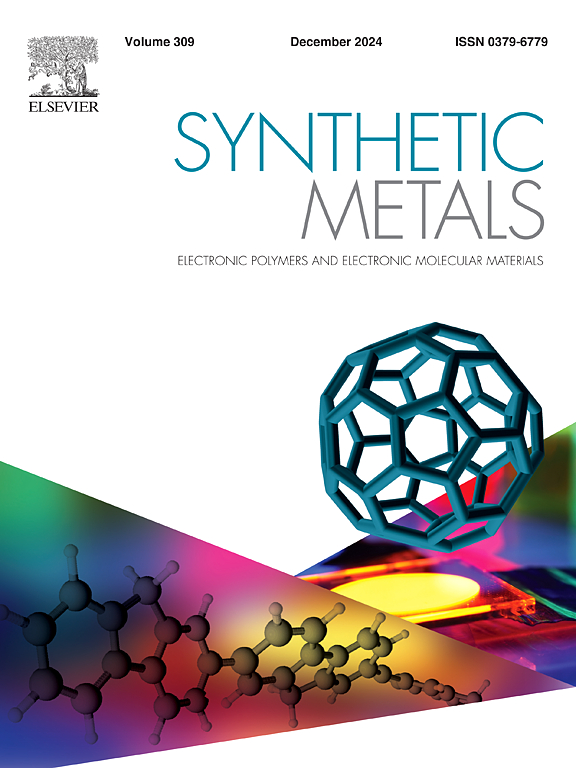通过异构化苯并二噻吩分子,调节分子聚合以提高聚合物的光伏性能
IF 4
3区 材料科学
Q2 MATERIALS SCIENCE, MULTIDISCIPLINARY
引用次数: 0
摘要
苯并[1,2-b:4,5-b']二噻吩衍生物(BDT)已被广泛用作合成聚合物供体材料的电子供体(D)单元。然而,其异构体苯并[2,1-b:3,4-b']二噻吩衍生物(iBDT)却很少被用于这一用途。本研究以 BDT 和 iBDT 为 D 分子,设计并合成了三种聚合物供体,即 PTz-BDT、PTz-iBDT-L 和 PTz-iBDT-H。值得注意的是,与 PTz-BDT 相比,基于 iBDT 的聚合物具有更优越的溶解性和更有利的聚集特性。当与非富勒烯受体 Y6 结合使用时,基于 iBDT 的聚合物显示出更有利的相形态、更紧密的堆积、更高的电荷迁移率、更平衡的电荷传输以及更少的器件电荷重组。因此,PTz-iBDT-H:Y6 PSC 的功率转换效率(PCE)达到了 11.04%,大大超过了基于 PTz-BDT 的 PSC(7.15%)和文献报道的基于 iBDT 的聚合物。这项研究介绍了一种通过异构化骨架并同步增加分子量来提高聚合物供体性能的有效方法。本文章由计算机程序翻译,如有差异,请以英文原文为准。
Tuning molecular aggregation to enhance photovoltaic performance of polymers by isomerizing benzodithiophene moiety
Benzo[1,2-b:4,5-b']dithiophene derivatives (BDT) have been extensively utilized as electron-donating (D) units for the synthesis of polymer donor materials. However, its isomers, benzo[2,1-b:3,4-b']dithiophene derivatives (iBDT), are rarely employed for this application. In this research, three polymer donors, namely PTz-BDT, PTz-iBDT-L, and PTz-iBDT-H, were designed and synthesized using BDT and iBDT as the D moieties, respectively. Notably, compared to PTz-BDT, the iBDT-based polymers exhibit superior solubility and more favorable aggregation properties. When combined with the non-fullerene acceptor Y6, the iBDT-based polymers exhibit a more advantageous phase morphology, tighter packing, higher charge mobilities, more balanced charge transport, and less charge recombination in the devices. Consequently, the power conversion efficiency (PCE) of the PTz-iBDT-H:Y6 PSC reaches 11.04 %, significantly surpassing those of the PSCs based on PTz-BDT (7.15 %) and the iBDT-based polymers reported in literature. This study introduces an effective approach to enhance the performance of polymeric donors by isomerizing its backbone and synchronously increasing its molecular weight.
求助全文
通过发布文献求助,成功后即可免费获取论文全文。
去求助
来源期刊

Synthetic Metals
工程技术-材料科学:综合
CiteScore
8.30
自引率
4.50%
发文量
189
审稿时长
33 days
期刊介绍:
This journal is an international medium for the rapid publication of original research papers, short communications and subject reviews dealing with research on and applications of electronic polymers and electronic molecular materials including novel carbon architectures. These functional materials have the properties of metals, semiconductors or magnets and are distinguishable from elemental and alloy/binary metals, semiconductors and magnets.
 求助内容:
求助内容: 应助结果提醒方式:
应助结果提醒方式:


